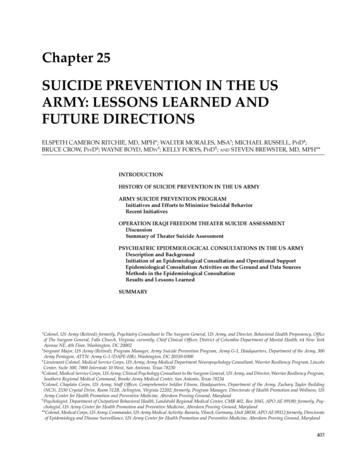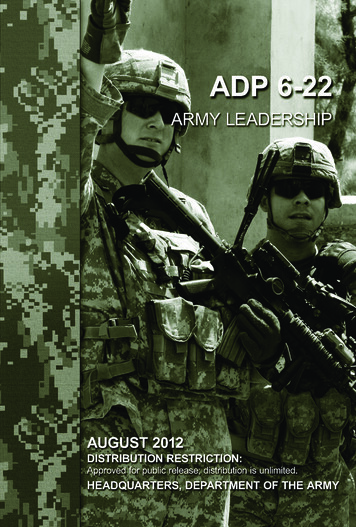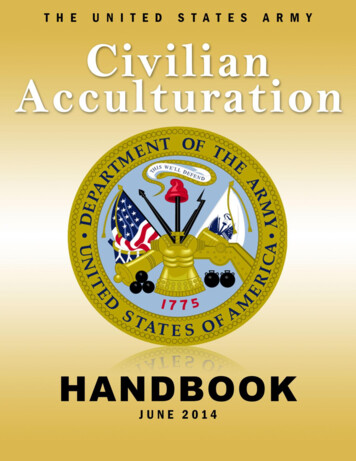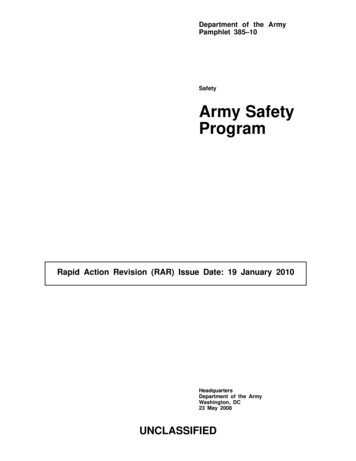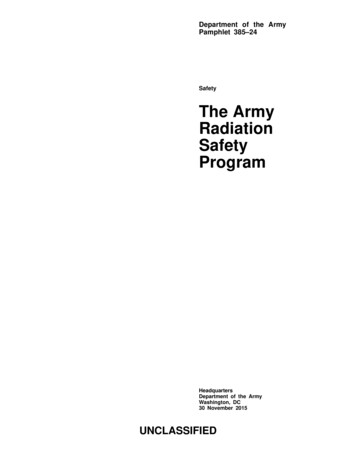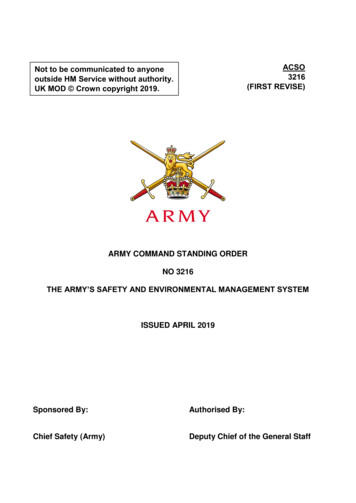
Transcription
ACSO3216(FIRST REVISE)Not to be communicated to anyoneoutside HM Service without authority.UK MOD Crown copyright 2019.ARMY COMMAND STANDING ORDERNO 3216THE ARMY’S SAFETY AND ENVIRONMENTAL MANAGEMENT SYSTEMISSUED APRIL 2019Sponsored By:Authorised By:Chief Safety (Army)Deputy Chief of the General Staff
Intentionally blank
UNCONTROLLED WHEN PRINTEDCONTENTSChief of the General Staff’s Personal Commitment to SafetyIntroductionArmy SEMS Methodology (Plan, Do, Check, Act)Chapter 1The Organisation and Arrangements for the Management ofSafety and Environmental Protection (S&EP) in the ArmyChapter 2Army Safety GovernanceChapter 3The Safe System of Work / Training (SSOW/T)Chapter 4Army Safety and Environmental Risk Management(including Risk Referral)Chapter 5Land Equipment Safety ManagementChapter 6Army Duty Holding (including Dispensation Process)Chapter 7FireChapter 8Portable Appliance Testing (PAT)Chapter 9Racking and ShelvingChapter 10Accident and Incident ReportingChapter 11Safety and Environmental Protection AssuranceChapter 12Safety and Environmental Protection Lessons Processi
UNCONTROLLED WHEN PRINTEDSAFETY AND ENVIRONMENTAL PROTECTION IN THE ARMYSTATEMENT OF INTENTby the Chief of the General StaffThe core purpose of the Army is to protect the UK, to defeat the UK’s enemies, to deal with disasterand to prevent future conflicts. As the Chief of the General Staff, and the Army’s Senior Duty Holder,I have personal responsibility for working, training and operating safely. This responsibilityencompasses all of our Officers, Soldiers, Civil Servants, contractors and the General Public. Toachieve this, I require you all to support me in this endeavour – looking after our people is my highestpriority. This is not new and is enshrined in the Army’s Leadership Code and our Values andstandards.You will all know that we have a legal duty to provide the right training for our soldiers and to be aneffective force. The British Army is rightly regarded as the best army in the world; this is no smallachievement having been developed and maintained by your professionalism in barracks, whilsttraining and on operations. I attach similar importance to Environmental Protection.To maintain our reputation, we need hard and challenging training to prepare us for whatever maylie ahead; I regard Safety as a key enabler for this and demand, that it be at the forefront of yourplanning and delivery outputs. We must never become over confident or complacent. Sadly, thecause of many avoidable incidents can be traced to activity that an individual is not prepared ortrained for or is taking place without proper supervision and in the worse cases an example of illdiscipline. None of this is excusable and, whist individual responsibility remains, I look to the Chainof Command to ensure that these circumstances do not occur.To do this effectively I require commanders at all levels to apply a Safe System of Training1. Bydoing so, we will achieve the correct balance between challenging training and acceptable risk. It isalso vital that we create the opportunity for soldiers to make honest mistakes in training, in pursuit oflearning lessons, in a safe environment. Of course, the difference between an honest mistake andnegligence must be understood. Our actions move from mere mistakes into negligence when wefail to exercise the care, skill or foresight expected of anyone with our personal training andexperience; negligence will not be tolerated. My desired end state is an Army able to demonstratethat we instinctively balance risk and safety in our decision making, underpinned by common senseand an understanding of both corporate (Chain of Command) and individual responsibility, in orderto operate safely and mindful of our environmental impact, to maintain our battle-winning tempo anddecisiveness.The Army is a responsible employer, and this means having a strong safety culture. I expect all ofyou to ensure that when deployed, when training, in your barracks or on the sports field, it is as safeas it can be. There is no space for a reckless or cavalier approach to Safety with the support andguidance contained within this ACSO.General Sir Mark Carleton-Smith KCB CBE ADC GenCGS1 Mar 191Safe Person, Safe Equipment, Safe Practice, Safe Place.ii
UNCONTROLLED WHEN PRINTEDARMY COMMAND STANDING ORDER NO 3216(FIRST REVISE)THE ARMY’S SAFETY AND ENVIRONMENTAL MANAGEMENT SYSTEMIntroductionReferences:A.B.C.D.E.Secretary of State for Defence Health, Safety and Environment Policy Statement.DSA 01.1 – Defence Health, Safety and Environmental Protection.JSP 375 – Management of Health and Safety in Defence.JSP 418 – Management of Environmental Protection in Defence.JSP 850 – Infrastructure and Estate Policy.Context1.The Army is required by UK law and Defence policy (References A – E) to minimise workrelated fatalities, injuries, ill-health and adverse effects on the environment from its activity. Morethan just a legal responsibility, this also enhances the physical and moral components of FightingPower. Consequently, Safety and Environmental Protection (S&EP) has leadership2 at its core andall Army personnel, irrespective of rank, have legal responsibilities under the Health and Safety atWork etc. Act 1974 (HASWA) to provide a Duty of Care to subordinates, each other and those whomay be affected by their acts or omissions. The Army delivers its Safety commitments inconjunction with Environmental Protection3.2.The Secretary of State for Defence (SoSfD) has ultimate responsibility for Health, Safety andEnvironmental Protection in Defence and has issued a Policy Statement. He has appointed thePermanent Secretary as the Department’s most senior official for Health, Safety andEnvironmental Protection (HS&EP) and he is required to ensure that effective managementarrangements are in place to achieve compliance with SoSfD’s Policy Statement. The PermanentSecretary is supported in this duty by the Defence Safety Authority (DSA) who regulate, assureand investigate HS&EP where there is a Departmental responsibility. Additionally, Health andSafety at Work is regulated by the Health and Safety Executive (HSE) and environmental mattersare regulated by the Environment Agency (EA) (or equivalents in Scotland, Wales and NorthernIreland).3.The HSE recommends an approach to safety based on a Plan, Do, Check, Act cycle (as setout in the HSE’s HSG 65 document4) which achieves a balance between systems and behaviouralaspects encouraging the integration of safety management with organisational managementgenerally. The term Safety and Environmental Management System (SEMS) is used by Defence5to describe the systematic approach that will be implemented for HS&EP management and thecollection of specific arrangements that underpin this implementation. The model is showngraphically below and is the framework for the Army’s SEMS.4.The HSE’s Plan, Do, Check, Act model balances the systems and behavioural aspects ofHealth and Safety leadership and management. It encourages approaching Health and Safetymanagement as an integral part of good management and leadership generally, rather than as a2Refer to the Army Leadership Code.It should be noted that the Defence Fire & Rescue (DFR) has the lead for Fire policy pan Defence and the Army’s Senior HealthAdvisor (SHA(A)) has the lead for Occupational Health.4HSE 65 – Managing for health and safety; http://www.hse.gov.uk/pUbns/priced/hsg65.pdf.5DSA 01.23iii
UNCONTROLLED WHEN PRINTEDstand-alone system. Widely used as an industry standard, it can be adapted to the full spectrum ofArmy activity.5.Structure. This ACSO utilises, where appropriate the Defence 2 Part structure:a.Part 1 - direction (shall; an activity that is mandatory).b.Part 2 – guidance (should; describes an activity that is considered to begood practice. If the activity is followed, then this will be considered sufficient todemonstrate compliance with this ACSO. However, alternative approaches maybe utilised where this produces an outcome as good as required by this ACSO).Plan, Do, Check, Act MethodologyDetermine thepolicy.Plan forimplementation.Profile Risks.Organise forhealth and safety.Implement GTHE PLANPOLICYLEARNINGLESSONSReviewperformance.Act on nvestigatingaccidents/incidents &near or beforeevents,investigate afterevents).The HSE Model – Plan, Do, Check, Act.Plan Identify and communicate what is to be achieved in terms of HS&EP, who will beresponsible for what, how aims will be achieved and how success will be measured.Capturing this in a policy and having a plan to deliver it will reduce ambiguity andensure intent is clear. Decide how performance will be measured in the AoR. Consider ways to do this that gobeyond looking at accident figures – looking at leading as well as lagging indicators.These are also called active and reactive indicators. Consider fire and other emergencies. Co-operate with anyone who shares theworkplace and ensure plans are co-ordinated.iv
UNCONTROLLED WHEN PRINTED Plan for changes and identify any specific requirements that apply.Do Identify HS&EP risk profile:oo Organise activities to deliver HS&EP plans and aims to:ooo Conduct Risk Assessments, identify what could cause harm in the workplace,who it could harm and how, and what needs to be done to manage the risk.Identify what the priorities are and identify the biggest risks.Involve all levels in the chain of command and communicate so that everyone isclear on HS&EP intent and their role in your plan.Foster and develop positive attitudes and behaviours – a strong and just SafetyCulture is critical.Provide adequate resources, including competent advice where needed.Implement the plan:oooooDecide on the preventive and protective measures needed and put them in place.Provide the right tools and equipment to do the job and keep them maintained.Train and instruct, to ensure everyone is competent to carry out their work.Supervise to make sure that arrangements are followed.Demand HS&EP rigour from the chain of command – they are the eyes and earsfor Risk Assessment on the ground and must demonstrate leadership in followingyour intent.Check Measure performance:ooo Make sure that plans have been implemented, ‘paperwork’ on its own is not agood performance indicator.Assess how well the risks are being controlled and if aims are being achieved.A robust audit regime (iaw ACSO 9001) is strongly recommended.Delivered through Mission Command, this delegation must be mentored andchecked resisting the urge to believe comforting assurances about S&EP.Investigate the causes of accidents, incidents or near misses:oooThe Defence Accident Investigation Branch (DAIB) will investigate all seriousaccidents, incidents and near misses.ASCen and APSG may request either an AF510A (Unit Investigation Report) or aLearning Accounts for specific accidents, incidents and near misses.Formations and units are recommended to conduct their own Learning processfor HS&EP events that do not meet the DAIB or ASCen/APSG thresholds butfrom which local lessons can be learned and preventative measures applied.v
UNCONTROLLED WHEN PRINTEDAct Review performance:ooo Learn from accidents and incidents, ill-health data, errors and relevantexperience, including from other Organisations.Regularly revisit plans, policy documents and risk assessments to see if theyneed updating.Encourage and teach Risk Assessment requirements and methods.Take action on lessons learned, including those from audit and inspection reports.vi
UNCONTROLLED WHEN PRINTEDCHAPTER 1THE ORGANISATION AND ARRANGEMENTS FOR THE MANAGEMENT OFSAFETY AND ENVIRONMENTAL PROTECTION IN THE ARMYAim1.This ACSO sets out the SEMS for Safety and Environmental Protection (S&EP) in the ArmyTLB.Compliance2.Compliance with the Army SEMS will be assured by the Army Inspectorate on a biennialbasis or as directed by CGS. However, statutory and Defence Regulators may also consider theeffectiveness of this SEMS as part of gathering regulatory evidence. The Army Safety Centre(ASCen) will ensure that these activities are coordinated to avoid duplication.Scope3.Directed by DCGS through ECAB, the SEMS regime creates the conditions to establish apositive S&EP culture throughout the Army ensuring the Chain of Command is not stifled in itsability to empower and delegate by allowing Commanders to manage risk according to context andlearn from genuine errors; whilst not accepting recklessness and/or negligence. It is intended toidentify risk and share good practice in the interests of continuous improvement. It is about makingMission Command work in peacetime and to ‘remove centralisation, over assurance andbureaucracy [which] stifles the Chain of Command’s ability to delegate and empower subordinatelevels’6.4.This ACSO maintains this approach and it applies to all Army units and establishments. Forthose Army units that lie outside the Army TLB, they should subscribe to their parent TLB SEMS.It also applies to S&EP delivered by the Army to other TLBs and has been written to align with theInternational Organisation for Standardisation (ISO)7.Plan5.CGS, as the Army’s Senior Duty Holder (SDH), is responsible and accountable to SoSfD forconducting Defence activities in his Area of Responsibility (AoR) safely, environmentallyresponsibly and compliant with legislation. The Army must implement S&EP managementsystems that are proportionate to the risks and hazards faced – the greater or more complex therisk, the more sophisticated the system required to manage it. It is essential that the Army has afull understanding of the risks it faces in order that the management of them is sensible,proportionate and conducive to the Army’s ethos, culture and requirement to deliver capability.Striking the right balance requires sound judgement and a strong, informed and ‘Just’ safetyculture8. The safety of personnel and the protection of the environment are intrinsically linked tothe Army’s core values, the Army Leadership Code and business objectives.6.Leaders and commanders must identify the S&EP risks in their AoR and establish safetymanagement systems, processes and governance frameworks to manage them to ALARP andtolerable9, ensuring a Safe System of Work/Training is in place. Risk Registers must be produced6CGS Intent - Army Command Plan 2018.The ISO family of Quality Management System’s standards is designed to help organisations meet the needs of customers and otherstakeholders and regulatory requirements related to a product eg ISO 45001.8Army Safety Strategy.9ALARP - "as low as reasonably practicable" - Reasonably Practicable involves weighing a risk against the trouble, time and moneyneeded to control it. When these are judged to exceed any further control of the risk, then ALARP and tolerable has been achieved.71-1
UNCONTROLLED WHEN PRINTEDthat identify priorities, focus resources, allocate and record Responsibility, Accountability andAuthority (RA2) and track risk controls. Subject Matter Expert (SME) advice from variousstakeholders will underpin effective safety management and Army S&EP performance, allowingrisks to be managed at the appropriate level with agile mechanisms in place for tolerance,treatment, transfer or termination as required.7.Mechanisms are to be established to measure S&EP performance by analysing leading andlagging indicators, such as (not exhaustive):a.Leading Indicators:(1)The extent to which plans, and objectives have been set and achieved.(2)The appointment of staff leads and ‘S&EP Champions’.(3)Publication of S&EP policies.(4)Sufficient trained and experienced personnel in supervisory posts.(5)Numbers of S&EP trained staff.(6)Number and quality of risk profiles and assessments.(7)Number and quality of Organisational Safety Assessments (OSAs)10.(8) Extent of compliance with risk controls (eg sufficient personnel, inductionbriefings, etc).(9)Extent of compliance with statutory and regulatory requirements.(10) Frequency and effectiveness of S&EP assurance activity.(11) Frequency and effectiveness of S&EP committee meetings.(12) Personal protective equipment usage (eg ear defence).(13) Number of Safety and/or Environmental Cases signed off (dual signature).b.Lagging Indicators:(1)Unsafe acts and conditions reported (including near misses).(2)Major accident, incidents and fatalities.(3)Sickness and injury-related absences.(4)Observations made by regulators (eg Enforcement Notifications)(5)Observations from assurance activity.(6)Observations made by personnel (eg whistleblowing).8.Environmental Protection. Whilst responsibility for a large component of EP sits with theDefence Infrastructure Organisation (DIO) as infrastructure providers and maintainers, the Army10DSA 01.2 Defence Policy Health, Safety and Environmental Protection - Chapter 7 (Organisational Safety Assessments).1-2
UNCONTROLLED WHEN PRINTEDhas a responsibility to ensure that its practices and procedures are EP compliant and that anyincident is effectively managed. JSP 418 requires an Environmental Management System (EMS)system to be put in place that is based on ISO 1400111. A bespoke Environmental ManagementSystem for Army Sites (EMSAS) pamphlet has been produced that provides a systematicapproach to EP that is to be established at unit level. EMSAS identifies unit activities, which couldhave an environmental impact and thus enables effective management and regular review. TheEMSAS pamphlet is here.Do9.Effective safety management allows the Army to do safely what is required and needs to doin the interests of Defence. S&EP risk management will normally involve several stakeholders andall are to understand their S&EP obligations; identifying, prioritising, managing and controlling therisks they are responsible for. Clear direction and appropriate supervision must be provided tomeet those obligations. The Risk Assessment is an essential element of effective riskmanagement by those directing and conducting hazardous activities; it is also a legal requirement.10. Safety Governance. As part of the Army’s SEMS all areas of the Army are to havestructured and empowered safety governance organisations and arrangements that enable S&EPrisks to be managed at the appropriate level. Commanders must set the example in energisingsafety governance, chairing meetings when appropriate to do so and taking an active leadershiprole in managing S&EP risks. Formation commanders and staff branch heads are to establishgovernance mechanisms that actively manage S&EP matters in their AoRs. Army HQ safetygovernance is at Chapter 2.11. Safe Systems of Work and Training (SSOW/T) must be identified for all activities, includingroutine activity. The SSOW/T is explained at Chapter 3 and consists of:a.Safe Persons.b.Safe Equipment.c.Safe Practice.d.Safe Place.12. The Army has a legal and moral Duty of Care obligation for the health, safety and welfare ofits personnel and those who might be affected by its acts or omissions. This obligation is universal(applied to all activities) and responsibility is vested in every individual from recruit to CGS.However, more is expected of commanders (from LCpl upwards) who direct and supervise activityto manage the risks they create and/or are confronted by. This is done by understanding the risks,making a judgement on whether the risk (potential adverse outcome) is worth the potential benefitand putting controls in place to reduce the risks to As Low As Reasonably Practicable (ALARP)and tolerable. The SSOW/T is a useful framework and will, in most cases, reduce risk to ALARPand tolerable ensuring Duty of Care obligations are being met.13. Where the risks are significant, but the activity must be conducted in the interests of Defence(ie live firing, flying, arduous physical training, etc.) CGS may direct that in order to meet Duty ofCare obligations the Duty Holding process is followed to add focus and emphasis to safety riskmanagement and an improved gearing for risk elevation. This Duty Holding framework will clearlyidentify those with RA2 for the management of safety risk when conducting the prescribed activities11ISO 14001:2015 sets out the criteria for an environmental management system; such a system can be certified to this standard. ThisISO maps out a framework that a company or organisation can follow to set up an effective environmental management system. It canbe used by any organisation regardless of its activity or sector.1-3
UNCONTROLLED WHEN PRINTEDand provide a mechanism for its effective resourcing and elevation of ownership when required. Inaccordance with Defence Duty Holding policy, there will be three levels of Duty Holder:a.Senior Duty Holder (SDH). This will always be CGS and is the level at which ultimateRA2 is held. The SDH will direct which activities are subject to Duty Holding and thestandards that are to be applied. Safety risk may be elevated from the Operating DutyHolder (ODH) to the SDH as required; in some instances, significant risks may need to beheld by the SDH, in others, the SDH may elevate the risk to SoSfD.b.Operating Duty Holder (ODH). This is the level at which CGS’s intent and direction isapplied within AoRs. It is normally vested at the 2* level and appointed by the SDH. TheODH provides the safety management link between the SDH and those routinely conductingthe activity at the Delivery level. The ODH will conduct 2nd Line of Defence assurance toensure compliance with CGS’ intent and direction, set standards and may direct resources tomitigate safety risk as required. Risk ownership may be elevated from the Delivery DutyHolder (DDH) to the ODH as required and the ODH may elevate risk to the SDH. ODHs willbe expected to provide an annual report to the SDH on how Duty Holding safety risks arebeing managed and controlled in their AoR.c.Delivery Duty Holder (DDH). This is the level at which CGS’ intent and the safetystandards to be applied are delivered by the appointed DDH; this is normally CommandingOfficers (CO) or in some cases independent sub-unit commanders12.d.Below the DDH, commanders at all levels are to ensure that a SSOW/T is in place forall activity. As directed by the DDH, additional scrutiny and control are likely to be applied tothose activities prescribed for Duty Holding and 1st Line of Defence assurance should befocused accordingly in meeting CGS’ intent. Commanders must maintain a SSOW/T.Where this cannot be maintained, but the activity must continue in order to accrue benefit,consultation with the DDH is required and the safety risk may be elevated if necessary.14. The ASC and ASSC will provide the forums at which the activities requiring Duty Holding areidentified, confirmed and monitored. Commanders and SMEs can offer opinion to either committeeon the requirement for Duty Holding. Full details of the Army Duty Holding policy are at Chapter 6and a DH training course is available on the DLE Code 101. Duty Holding training is valid for 3years and must be refreshed if Duty Holding responsibilities endure beyond that time.15. Safety Responsibilities/Organisation. The following personnel have key roles in S&EPmanagement.a.CGS. CGS sets the standard for Army S&EP and is ultimately responsible for theSafety of all Army TLB personnel. They are supported in this role by the Chain of Commandand the Executive Committee of the Army Board, which is briefed quarterly by the ArmyInspector on the Army’s S&EP performance. CGS chairs the Army TLB senior safety forum,the annual ASC, which considers Army S&EP risk management and performance, refinespolicy and sets safety objectives and priorities.b.DCGS. DCGS is the Army’s ‘Safety Champion’. He chairs the biannual ASSC, whichmonitors Ar
C. JSP 375 - Management of Health and Safety in Defence. D. JSP 418 - Management of Environmental Protection in Defence. E. JSP 850 - Infrastructure and Estate Policy. Context 1. The Army is required by UK law and Defence policy (References A - E) to minimise work-





